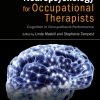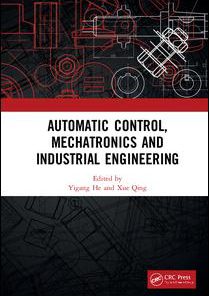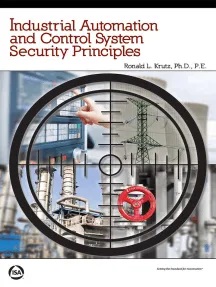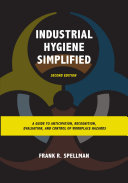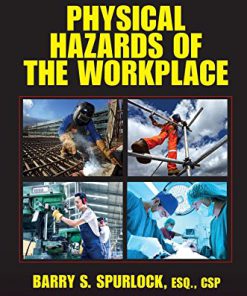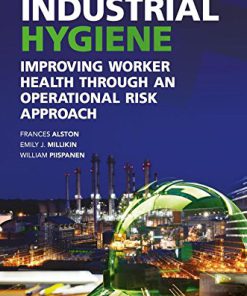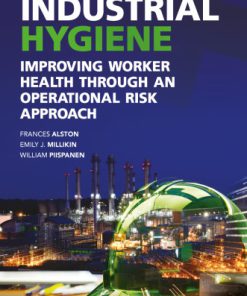Industrial Hygiene Control of Airborne Chemical Hazards 2nd Edition by William Popendorf ISBN 1351238035 9781351238038
$50.00 Original price was: $50.00.$25.00Current price is: $25.00.
Industrial Hygiene Control of Airborne Chemical Hazards 2nd Edition by William Popendorf – Ebook PDF Instant Download/Delivery: 1351238035, 9781351238038
Full download Industrial Hygiene Control of Airborne Chemical Hazards 2nd Edition after payment

Product details:
ISBN 10: 1351238035
ISBN 13: 9781351238038
Author: William Popendorf
Are you a practicing occupational hygienist wondering how to find a substitute organic solvent that is safer to use than the hazardous one your company is using? Chapter 6 is your resource. Are you a new hygienist looking for an alternative technology as a nonventilation substitute for an existing hazard? Chapter 8 is your resource. Are you looking for an overview of ventilation? Chapters 10 and 11 are your resource? Are you an industrial hygiene student wanting to learn about local exhaust ventilation? Chapters 13 through 16 are your resource. Are you needing to learn about personal protective equipment and respirators? Chapters 21 and 22 are your resources. This new edition brings all of these topics and more right up-to-date with new material in each chapter, including new governmental regulations. While many of the controls of airborne hazards have their origins in engineering, this author has been diligent in explaining concepts, writing equations in understandable terms, and covering the topics of non-ventilation controls, both local exhaust and general ventilation, and receiver controls at the level needed by most IHs without getting too advanced. Taken as a whole, this book provides a unique, comprehensive tool to learn the challenging yet rewarding role that industrial hygiene can play in controlling airborne chemical hazards at work. Most chapters contain a set of practice problems with the solutions available to instructors. Features Written for the novice industrial hygienist but useful to prepare for ABIH certification Explains engineering concepts but requires no prior engineering background Includes specific learning goals that differentiate the depth of learning appropriate to each topic within the fuller information and explanations provided for each chapter Contains updated governmental regulations and abundant references Presents a consistent teaching philosophy and approach throughout the book Deals with both ventilation and non-ventilation controls.
Industrial Hygiene Control of Airborne Chemical Hazards 2nd Table of contents:
Chapter 1 An Introduction to Industrial Hygiene Chemical Hazard Control
I. An Overview of Industrial Hygiene
II. The Spatial Spectrum of Exposure Scenarios
III. The IH Paradigm of Control Priorities
IV. The Approach and Philosophy of This Book
V. Learning Goals and Special Notations
References
Chapter 2 The Behavior of Gases and Vapors
I. Gas and Vapor Definitions
II. Vapor Pressure Changes with Liquid Temperature
III. IH Uses of Dalton’s Law
IV. IH Uses of the Ideal Gas Law
V. The Effects of T and P on Airborne Concentration
VI. The Effects of T and MW on Plume Density
VII. Dense Vapors
Practice Problems
References
Chapter 3 The Behavior of Aerosols
I. How Aerosols Differ from Gases and Vapors
II. Aerosol Definitions
III. Particle Diameter Distributions
IV. Modeling Particle Behavior
V. Stokes and Aerodynamic Diameters
VI. Aerosol Diameters and Human Health
Practice Problems
References
Chapter 4 Control Criteria for Airborne Chemicals
I. Performance and Specification Standards
II. Airborne Chemical Exposure Limits
III. Health Criteria for Airborne Chemical Limits
IV. Safety Criteria for Airborne Chemical Limits
V. Criteria for Oxygen Deficiency Limits
VI. Comparisons among Criteria and Limits
VII. OSHA Ventilation Standards
VIII. Open-Surface Tanks
Practice Problems
References
Chapter 5 Vapor Generation, Behavior, and Hazards
I. Mechanisms of Vapor Generation
II. Mechanisms of Plume Dispersion
III. Four Airborne Exposure Scenarios
IV. Vapors with and without Ventilation
V. Vapors from Incomplete Evaporation with No Ventilation
VI. Vapors from Complete Evaporation with No Ventilation
VII. Differentiating between Complete and Incomplete Evaporation
VIII. Vapors from Continuous Evaporation with Ventilation
IX. Introduction to the VHR
Practice Problems
References
Chapter 6 Vapor Pressure within Mixtures
I. Mixtures
II. Defining Liquid Mixtures Quantitatively
III. Raoult’s Law for Ideal Liquid Mixtures
IV. The Behavior of Nonideal Liquid Mixtures
V. Predicting an Activity Coefficient
VI. Henry’s Law
VII. Measuring Mixtures Experimentally
VIII. Applying Predictive Methods to Mixtures
Practice Problems
References
Chapter 7 Changing the Workplace
I. The Technologic Dimensions of Change
II. The Psychosocial Dimensions of Change
III. The Economic Dimensions of Change
References
Chapter 8 Source Control via Substitution
I. Substitutions Using Alternative Technologies and Processes
II. Volatility and Toxicity in Chemical Substitutions
III. Substitutions Using Aqueous Cleaners
IV. Substitutions Using Semi-Aqueous Cleaners
V. Substitutions Using Volatile Organic Cleaners
VI. Substitutions using the VHR
Practice Problems
References
Chapter 9 Other Source and Nonventilation Pathway Controls
I. Nonvolatile Chemical Source Controls
II. Volatile Chemical Source Controls
III. Modifying Volatile Chemical Source Variables
IV. Work Practices as an Exposure Control
V. Automation as an Exposure Control
VI. Separation as an Exposure Control
VII. Isolation as an Exposure Control
VIII. Compilation of Memorable Nonventilation Control Equations
Practice Problems
References
Chapter 10 An Overview of Local Exhaust Ventilation
I. Local Exhaust Ventilation Terminology
II. Principles of LEV
III. Designing an LEV System
References
Chapter 11 Ventilation Flow Rates and Pressures
I. Applying Conservation of Mass to Ventilation
II. Applying Conservation of Energy to Ventilation
III. Static Pressures (P and SP)
IV. Velocity Pressure (VP)
V. Total Pressure and Pressure Losses
VI. Compilation of Memorable Ventilation Control Equations
Practice Problems
Appendix to Chapter 11
References
Chapter 12 Measuring Ventilation Flow Rates
I. Qualitative Air Flow Indicators
II. Manometers
III. Aerodynamic Velocity Meters
IV. Thermodynamic Velocity Meters
V. The Boundary Layer
VI. Assessing Flow Inside Ducts
VII. Calibrating Anemometers
References
Chapter 13 Designing and Selecting Local Exhaust Hoods
I. Local Exhaust Hood Design Principles
II. Selecting a Control Velocity
III. Using the DallaValle Equation
IV. Designing a Slotted Collection Hood
V. Designing a Hood Using an ACGIH “VS” Diagram
VI. Designing a Hood for an Open Surface Tank
VII. Designing a Canopy Hood Over an Isothermal Source
VIII. Designing a Canopy Hood Over a Hot Source
IX. Designing a Push–Pull Hood System
X. Using an Air Shower
XI. Using Commercial and Other Specialty Hoods
Practice Problems
References
Chapter 14 Predicting Pressure Losses in Ventilation Systems
I. A Primer on Energy and Pressure Losses
II. Losses at Hood Entry
III. Selecting a Duct Velocity
IV. Selecting the Duct Size and Material
V. Losses in Straight Ducts
VI. An Example of Hood Entry and Duct Losses
VII. Duct Fittings
VIII. Losses at Elbows
IX. Losses at Duct Contractions
X. Losses at Duct Expansions
XI. Comparing Contraction and Expansion Losses
XII. Losses in Branched Duct Systems
XIII. An LEV Design Worksheet
Practice Problems
References
Chapter 15 Exhaust Air Cleaners and Stacks
I. Air Cleaning Needs and Options
II. Air Cleaner Selection Criteria
III. Particulate Aerosol Cleaners
IV. Gas and Vapor Cleaners
V. Aerosol, Gas, and Vapor Cleaners
VI. Exhaust Stacks and Re-entrainment
Practice Problems
References
Chapter 16 Ventilation Fans
I. Air Mover Terminology
II. Matching Fan Performance to System Requirements
III. Axial Fans
IV. Centrifugal Fans
V. The Fan Laws
VI. Fan Selection and Installation
Practice Problems
References
Chapter 17 Ventilation Operating Costs
I. Fan Efficiency and Power Consumption
II. Electricity Costs for Fans
III. Supplying Make-Up Air
IV. Heating Costs for Make-Up Air
V. Cooling Costs for Make-Up Air
VI. Energy Conservation
Practice Problems
References
Chapter 18 Local Exhaust Ventilation System Management
I. Why Monitor System Performance
II. When to Monitor System Performance
III. What, Where, and How to Monitor System Performance
IV. Troubleshooting
V. Post-Installation Adjustments
Practice Problems
References
Chapter 19 General Ventilation and Transient Conditions
I. General Ventilation and Chemical Control
II. The Dilution Ventilation Model
III. The General Solution to the Dilution Ventilation Model
IV. Dynamic Concentrations during a Stepwise Increase
V. Dynamic Concentrations during a Stepwise Decrease
VI. Dynamic Concentrations with No Ventilation
Practice Problems
References
Chapter 20 General Ventilation in Steady-State Conditions
I. Airborne Concentrations in Steady-State Conditions
II. Normal Building Ventilation Requirements
III. Components of General Ventilation (HVAC) Systems
IV. Causes of Indoor Air Quality Problems
V. Assessing General Ventilation Air Flow Rates
VI. Controlling Indoor Sources Via Dilution Ventilation
Practice Problems
References
Chapter 21 Administrative Controls and Chemical Personal Protective Equipment
I. Administrative Controls
II. Personal Protective Equipment [PPE]III. Chemical PPE Program Management
IV. Terms and Concepts Regarding Chemical PPE
V. Recognizing Dermal Hazards
VI. Selecting Chemical Protective Gloves
VII. Selecting Chemical Protective Clothing
VIII. Selecting Chemical Protective Ensembles
References
Chapter 22 Respirator Controls
I. Respirator Terms and Concepts
II. Many Protection Factors
III. Respirator Fit and Seal Testing
IV. Variables Affecting Protection Factors
V. Respiratory Protection Program Management
VI. A Respirator Selection Protocol
People also search for Industrial Hygiene Control of Airborne Chemical Hazards 2nd:
industrial hygiene control of airborne chemical hazards
what are the industrial hygiene hazards
what are airborne chemicals
airborne hazards examples
airborne chemicals examples
Tags:
William Popendorf,Industrial Hygiene Control,Airborne Chemical Hazards
You may also like…
Engineering
Industrial Automation and Control Systems Security Principles Second Edition Ronald L. Krutz
Engineering - Electrical & Electronic Engineering
Fundamentals of Industrial Instrumentation and Process Control, Second Edition William C Dunn
Engineering
Bretherick’s Handbook of Reactive Chemical Hazards 8 ed. Eighth Edition Urben P.G. (Ed.)
Engineering
Industrial Hygiene : Improving Worker Health through an Operational Risk Approach 1st Edition Alston
Cookbooks
Engineering



